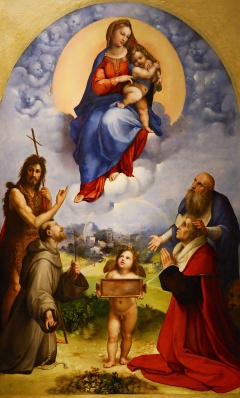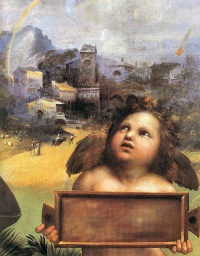(Unless otherwise stated, the copyright of the materials included belong to Jan Woreczko & Wadi.)
Madonna di Foligno (Rafael, obraz)
Z Wiki.Meteoritica.pl
Madonna di Foligno – obraz namalowany w roku 1512 przez Rafaela Santi na zlecenie Sigismondo Conti. Przestawia Marię, Jana Chrzciciela, św. Franciszka, św. Hieronima oraz postać donatora. Interesujący jest namalowany w tle pejzaż na którym widać tęczę i „błyskawicę uderzającą w dom zleceniodawcy” (za Wikipedią). Lecz błyskawica ta bardziej przypomina bolid!?
Już wcześniej wielu historyków sztuki zwracało uwagę na ten tajemniczy detal na obrazie. Hasan Niyazi (portal 3PipeProblem) omawiając m.in. dwa detale tła – pustą tabliczkę trzymaną przez anioła (tabula ansata) oraz obiekt opisywany jako błyskawica – ten drugi identyfikuje jako meteor. Fragment dotyczący meteoru (portal 3PipeProblem):
A meteorite?
Nineteenth century authors described a small background object depicted with a flame trailing behind it as an aerolite, or meteorite - theorising that the painting referred to an event affecting the patron. In an 1890 publication of the Astronomical Society of the Pacific, Edward S. Holden notes:
- Its purely astronomical interest consists in the portryal of the fall of the aerolite itself, which occupies the centre of the picture.[12][1]
Another explanation was offered by Professor H. A Newton, following up in 1891 on Holden’s notice the previous year. Newton cites a phenomenon reported in several contemporary sources:
- On the 4th of September, 1511, in the second hour of the night, there fell on the banks of the Adda, near Crema, some leagues southeast of Milan, a number of stones [...][2] We may well question nearly all the details of all the accounts, but that many stones fell and some were carried to Milan and other cities, can hardly be doubted. It is, so far as I know, the only detonating meteor falling in Italy during several years preceding 1512, of which account has been preserved. I believe that Raphael meant to represent this Crema aerolite in his painting of the Foligno Madonna.[13]
This object was also addressed by Schröter in 1987, emphasising that early sources do not mention that Sigismondo personally endured any form of bombardment or a lightning strike.[14] Schröter further suggests that the object depicted was a comet, symbolic of plague or an impending disaster. This is refuted by Meyer zur Capellen, arguing that the bright palette of the work does not match the types of works commonly associated with plague.[15] (…)
Zapewne nie dowiemy się co tak naprawdę namalował Rafael – błyskawicę, meteor, spadek meteoryty, kometę – czym się inspirował i co chciał przekazać w swoim dziele?
Przypisy
Linki zewnętrzne
- Wikipedia – Madonna di Foligno ● Rafael Santi
- Portal 3PipeProblem – Three Pipe Problem: Raphael's Altar of Heaven - the Madonna di Foligno
- woreczko.pl – Wydarzenia 2012 • Events 2012

